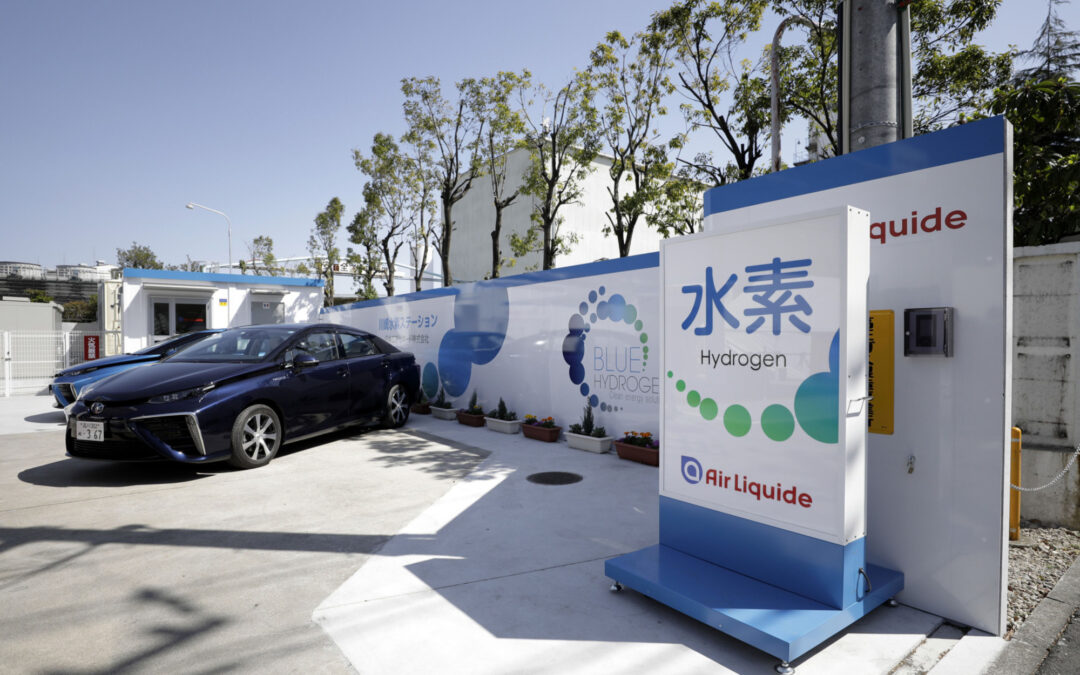Back in my college days, a good friend and I would theorize endlessly about how the world would change when “cheap fusion” finally gets figured out. Of course, as I sit here, four decades later, cheap fusion is still “just a couple decades away,” but some of its benefits, supportable by other power sources, are now within our grasp.
One such is the hydrogen fuel cell. Fuel cells are a very simple technology: they combine hydrogen and air in a catalytic reaction (not burning) to produce electricity, heat, and water. They are, in essence, batteries that don’t “deplete” or need recharging, but instead rely on a supply of hydrogen gas the way our present-day cars rely on a tank of gas.
They’re not new tech. They were invented in the early-mid 1800s, they are used in thousands of warehouse forklifts today, and the Space Shuttle relied on them.
Our “cheap fusion” vision involved cracking water into hydrogen and oxygen via electrolysis (you probably did that experiment in high school chemistry) at the big power plants, and then transporting it to gas stations where it would be pumped into cars equipped with fuel cells and electric motor drive systems.
Today, we have the electric motor drive systems figured out. Every major car manufacturer is making hybrids and electric cars. Over in Japan, they’re taking the next step. Toyota introduced a fuel cell car in 2014, sold about 10,000 of them so far, and recently launched its second generation version last year. The government has subsidized over a hundred hydrogen fueling stations, as part of a broader effort toward carbon neutrality.
The Biden administration could and should take a cue from this, and reconsider its grand ambition to build half a million EV charging stations (and the power grid to supply them all). Instead of a radical new infrastructure, at an astronomical cost, it could tip the scales slightly differently, and suggest that the auto makers work on fuel cell electric vehicles (FCEVs) rather than battery cars. There are 168,000 gas stations in the US, and it’d be a whole lot easier to change some tanks and pumps at existing locations than running high-capacity wire to half a million new spots across the country.
Furthermore, just as CFL light bulbs served as a “bridge” technology from incandescents to LEDs, battery cars would be a bridge to hydrogen fuel cell cars. Battery cars, like CFLs, are “dirtier” and present bigger disposal issues than hydrogen fuel cell cars and LED light bulbs.
Of course, there is a caveat: “Well-to-wheel” efficiency is significantly greater for battery cars than for hydrogen cars. If cheap fusion were with us, this wouldn’t matter. But since it’s not, it does, and so the cost of power to the consumer matters. However, efficiency isn’t an “in a vacuum” metric. Infrastructure, charging times, “range anxiety” and scalability are all major aspects of a comparison between batteries and fuel cells, and in all these, fuel cells have a massive advantage. They also have an advantage in metals. A fuel cell car needs about 50 grams of platinum for its catalyst (combustion engine catalytic converters require 5 grams), whereas a typical battery EV requires over 20 lbs of lithium (and we are already witnessing questions as to whether there’s enough lithium out there to supply all our battery needs).
Which wins in an overall cost comparison is a complex multivariate question, muddled by government’s countless distortions, difficult to peg down given the difficulty in predicting technological evolution, and made even more complex by the differing impacts on consumer behaviors. In terms of ease of implementation, however, and especially if we get over our baseless societal aversion to nuclear fission power, hydrogen fuel cells win the day. As they do in overall environmental cleanliness when life-cycle considerations are included. A 2017 survey informs us that a large majority of auto industry executives believe that FCEVs are the real future.
The biggest problem lies in the reality that, given how our economies and governments operate, someone in power has to make a choice. That person (or persons) and that choice will be undoubtedly influenced by countless external forces, including consumers, voters, and special interests.
The special interests, being always about OPM, won’t necessarily be advocating that which makes our lives easiest, so it’s up to us to make it clear what we prefer. A car that can be filled up in a couple minutes, or one that needs to be plugged in for hours? A technology that can use existing gas stations, or one that will require a massive rebuilding of our landscape? Two ounces of platinum, or 22 pounds of lithium (and enough cobalt to make for an even bigger supply chain concern)? That the carnie-grifter Elon Musk, who built his empire with taxpayer dollars, has said very nasty and disparaging things about FCEVs only cements my opinion in their favor.
The choice to me is clear.


An other problem is they are not ZERO Emission
Yeah it’s just water but who said Government regulations have to make sense
There are a couple of problems with hydrogen powered vehicles. Both fuel cell and IC vehicles would have the problem of how to distribute, dispense and contain hydrogen. Hydrogen is actually difficult to contain. The other is that it is expensive to produce, from an energy standpoint.
There is an alternative, however. There are fuel cells that use methane. Natural gas. Natural gas IC vehicles are widespread and a mature technology. Thus, distribution and containment are problems that have already been solved. And, the energy cost for production is *much* lower. The advantage of using methane in fuel cells instead of IC is a matter of efficiency.
Max efficiency is not the point, the tradeoff between “zero emission” options within the context of a power grid being converted to wind and solar (and if they wake the fuck up) nuclear.
Within that framework, I argue that the infrastructure challenges of FCEVs are cheaper and more surmountable than BEVs, and the FCEVs also solve the recharging time problem.